#Black Freedom Fighters
Explore tagged Tumblr posts
Text


Harriet Tubman (c. 1822–1913) was an abolitionist, freedom fighter, and humanitarian best known for her role as a conductor on the Underground Railroad, where she led hundreds of enslaved people to freedom. She was also a spy, scout, nurse, and soldier for the Union Army during the Civil War, making her one of the most fearless and effective leaders in the fight against slavery.
Born into slavery in Dorchester County, Maryland, Tubman endured brutal treatment at the hands of enslavers. Despite suffering a severe head injury as a child—causing lifelong headaches and visions—she developed a deep spiritual connection that guided her throughout her life. In 1849, she escaped slavery, traveling alone over 100 miles to the North, where she found freedom. However, she refused to stay free while others remained in bondage.
Determined to liberate her people, Tubman returned to the South at least 13 times, leading approximately 70 enslaved people to freedom through the Underground Railroad, a secret network of safe houses and abolitionists. Her success earned her the nickname “Moses”, as she never lost a single passenger on her dangerous journeys. She used disguises, secret codes, and her knowledge of the land to outmaneuver slave catchers, who placed large bounties on her capture.
During the Civil War, Tubman worked as a spy and scout for the Union Army, using her knowledge of the South to gather intelligence and organize guerrilla missions. In 1863, she led a daring raid on the Combahee River, which resulted in the liberation of over 750 enslaved people—one of the largest emancipation missions of the war. Her contributions to the Union war effort made her one of the few women to lead a military operation during that time.
After the war, Tubman dedicated her life to advocating for the rights of Black people and women. She worked to support formerly enslaved people, campaigned for women's suffrage, and established a home for elderly African Americans in Auburn, New York. Despite her immense contributions, she struggled financially and was not properly compensated for her wartime service.
Harriet Tubman’s legacy is one of fearless resistance, self-sacrifice, and an unshakable commitment to Black liberation. Her work not only freed individuals from physical slavery but also laid the foundation for future generations in the fight for civil rights, self-determination, and justice. She remains one of the most revered figures in African American and global history, embodying the spirit of liberation and resilience.
#harriet tubman#black history#black people#blacktumblr#black tumblr#black#pan africanism#black conscious#africa#black power#black empowering#black woman#black americans#black freedom fighters
215 notes
·
View notes
Text
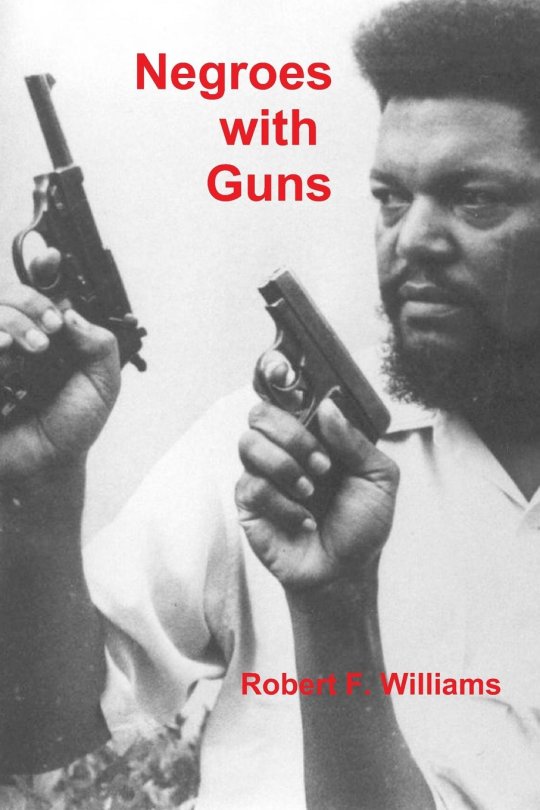
Negroes with Guns - Robert F. Williams
click the title link to Download for FREE from The BLACK TRUEBRARY
Negroes with Guns is a 1962 book by civil rights activist Robert F. Williams. Timothy B. Tyson said, Negroes with Guns was "the single most important intellectual influence on Huey P. Newton, the founder of the Black Panther Party".
The book is used in college courses and is discussed in debates. Negroes with Guns was Williams' experience throughout the Civil Rights Movement of Monroe, North Carolina.
Because black rights were constantly violated, the self-defense policy was born, with Williams saying there was a need to "meet violence with violence." However, Williams claimed that black militants were not promoting violence, but were combating it, believing in self-defense and not aggression.
youtube
NEGROES WITH GUNS: Rob Williams and Black Power tells the dramatic story of the often-forgotten civil rights leader who urged African Americans to arm themselves against violent racists. In doing so, Williams not only challenged the Klan-dominated establishment of his hometown of Monroe, North Carolina, he alienated the mainstream Civil Rights Movement, which advocated peaceful resistance.
For Williams and other African Americans who had witnessed countless acts of brutality against their communities, armed self-defense was a practical matter of survival, particularly in the violent, racist heart of the Deep South.
As the leader of the Monroe chapter of the National Association for the Advancement of Colored People (NAACP), Williams led protests against the illegal segregation of Monroe’s public swimming pool. He also drew international attention to the harsh realities of life in the Jim Crow South.
All the while, Williams and other protestors met the constant threat of violence and death with their guns close at hand. In August 1961, the Freedom Riders, civil rights activists trained by Martin Luther King, Jr. to lead non-violent resistance, came to Monroe to demonstrate the superiority of passive resistance. An angry mob turned on the protestors and, by the end of the day, the Freedom Riders had been bloodied, beaten and jailed, and Rob Williams was on the run from the FBI.
Backed by a jazz score by Terence Blanchard (Barbershop and the films of Spike Lee), NEGROES WITH GUNS uses interviews, rare archival footage and searing photographs to chronicle Williams’ rise to notoriety, his eight-year exile in Cuba and Mao Zedong’s China and his much-publicized return home in 1969. Voices include historians, members of Williams’ Black Guard—armed men committed to the protection of Monroe’s black community—and Williams’ widow, Mabel. For eight years, Williams and his family lived in exile, first in Cuba and then in China.
In Havana, Williams began to broadcast a 50,000-watt radio program called "Radio Free Dixie." Selected recordings are featured in NEGROES WITH GUNS. The radio show fused cutting-edge music with news of the black freedom movement and Williams’ editorials, which, among other things, urged blacks not to fight in Vietnam.
In exile from 1961 to 1969, at the height of the American Civil Rights Movement, Rob Williams and his accomplishments have been largely erased from the public consciousness. According to the filmmakers, NEGROES WITH GUNS helps to “restore Rob and Mabel Williams to their rightful place as important civil rights figures who defied the white power structure without the protection of large numbers or the attention of television cameras.”
click the title link to Download for FREE from The BLACK TRUEBRARY
#Negroes with Guns - Robert F. Williams#Robert F Williams#RNA#Republic of New Africa#Black Self Defense#Mabel Williams#Black Freedom Fighters#Youtube
22 notes
·
View notes
Text
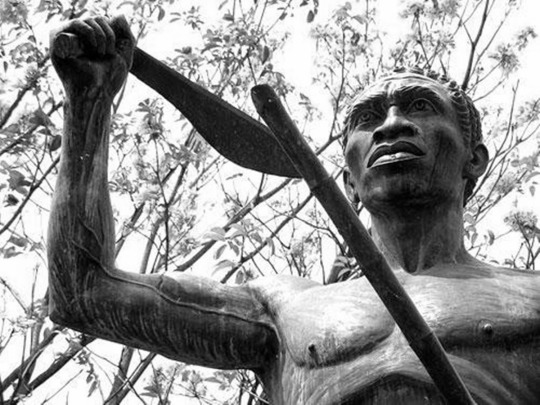
Known as the Primer Libertador de America or “first liberator of the Americas,” Gaspar Yanga led one of colonial Mexico’s first successful slave uprisings and would go on to establish one of the Americas earliest free black settlements.
Rumored to be of royal lineage from West Africa, Yanga was an enslaved worker in the sugarcane plantations of Veracruz, Mexico. In 1570 he, along with a group of followers, escaped, fled to the mountainous regions near Córdoba, and established a settlement of former slaves or palenque. They remained there virtually unmolested by Spanish authorities for nearly 40 years. Taking the role of spiritual and military leader, he structured the agricultural community in an ordered capacity, allowing its growth and occupation of various locations.
During that time, Yanga and his band, also known as cimarrónes, were implicated in the disruption and looting of trade goods along the Camino Real (Royal Road) between Veracruz and Mexico City. They were also held responsible for attacking nearby haciendas and kidnapping indigenous women. Perceived as dangerous to the colonial system of slavery through their daring actions against royal commerce and authority, New Spain’s viceroy called for the annihilation of Yanga’s palenque. Destroying the community and its leader would send a message to other would-be rebellious slaves that Spain’s authority over them was absolute.
In 1609, Spanish authorities sent a well-armed militia to defeat Yanga and his palenque but were defeated. Yanga’s surprise victory over the Spanish heightened the confidence of his warriors and the frustration in Mexico City.
After defeating other Spanish forces sent again the palenque, Yanga offered to make peace but with eleven conditions, the most important being recognition of the freedom of all of the palenque’s residents prior to 1608, acknowledgment of the settlement as a legal entity which Yanga and his descendants would govern, and the prohibition of any Spanish in the community. Yanga, in turn, promised to serve and pay tribute to the Spanish crown. After years of negotiations, in 1618, the town of San Lorenzo de Los Negros was officially recognized by Spanish authorities as a free black settlement. It would later be referred to as Yanga, named after its founder.
•••
Conocido como el primer libertador de las Americas, Gaspar Yanga lideró exitosamente una de las primeras revueltas de esclavos en el México colonial y estableció una de las primeras ciudades negras y libres de América.
Se rumoreaba que era del linaje real de África Occidental. Yanga fue un esclavo que trabajó en las plantaciones de caña de azúcar de Veracruz, México. En 1570, él junto con un grupo de sus partidarios, se escaparon y huyeron hacia las montañas ubicadas en las regiones cercanas a Córdoba y estableció la primer ciudad o asentamiento para antiguos esclavos, también llamado palenque. Prácticamente permanecieron ahí por casi cuarenta años, sin ser molestados por las autoridades Españolas. Tomando el rol de guía espiritual y militar, él organizó la comunidad agrícola con una capacidad ordenada, así permitiendo el crecimiento y ocupación de varias ubicaciones.
Durante este tiempo, Yanga y su banda, también conocidos como cimarrones, estuvieron implicados en la interrupción y saqueo de bienes comerciales a lo largo del Camino Real entre Veracruz y Ciudad de México. También se les responsabilizó por los ataques a las haciendas cercanas y de secuestrar a mujeres indígenas. Percibido como un peligro para el sistema colonial de la esclavitud, sus audaces acciones contra el comercio y la autoridad real hicieron que el virrey de Nueva España pidiera la aniquilación del palenque de Yanga. El destruir a la comunidad y a su líder enviaría un mensaje a otros posibles esclavos rebeldes de que la autoridad de España sobre ellos era absoluta.
En 1609, las autoridades españolas enviaron una milicia fuertemente armada para derrotar a Yanga y su palenque, pero fueron derrotadas. La sorpresiva victoria de Yanga sobre los españoles aumentó la confianza de sus guerreros y la frustración en la Ciudad de México.
Después de derrotar a otras fuerzas españolas enviadas nuevamente al palenque, Yanga se ofreció a hacer las paces pero con once condiciones, siendo la más importante el reconocimiento de la libertad de todos los que residían en el palenque desde antes de 1608, el reconocimiento del asentamiento como entidad legal que sería gobernado por Yanga y sus descendientes, y la prohibición de cualquier español en la comunidad. Yanga, a su vez, se comprometió a servir y rendir homenaje a la corona española. Después de años de negociaciones, en 1618, el pueblo de San Lorenzo de Los Negros fue reconocido oficialmente por las autoridades españolas como un asentamiento negro y libre. Más tarde se la conocería como Yanga, en honor a su fundador.
#mexico#blackhistory#history#mexican#black history is everybody's history#historia africana#historyfacts#heritage#black history is world history#black history is american history#africanhistory365#africanhistory#africanheritage#blacklivesalwaysmatter#blacklivesmatter#blackhistorymonth#blackpeoplematter#mexican history#knowyourhistory#african history#black history#black history month#historia#culture#blackhistoryyear#blackownedandoperated#freedom fighters#freedom#knowledgeispower#knowledgeisfree
72 notes
·
View notes
Text

Blue Beetle and the All-Star Squadron & Freedom Fighters by Jerry Ordway
#blue beetle#dan garrett#liberty belle#flash#sandman#sandy the golden boy#black condor#green lantern#alan scott#the guardian#hawkgirl#t n t#dan the dyna mite#human bomb#cherry bomb#sparky#jerry ordway#dc comics#modern age#james robinson#paula sevenberger#all star squadron#freedom fighters
68 notes
·
View notes
Text

A great cover re-creation of Justice League 107. Art by Mariano Navarro.
#freedom fighters#uncle sam#phantom lady#human bomb#the ray#doll man#black condor#justice league of america#jsa#justice society of america#black canary#superman#batman#elongated man#barry allen#doctor fate#the sandman#hal jordan#green lantern
22 notes
·
View notes
Text

DEAD
Rich Buckler
#Freedom Fighters#Earth X#Human Bomb#Phantom Lady#Doll Man#Wonder Woman#Uncle Sam#Black Condor#Ray#Rich Buckler#Dead
37 notes
·
View notes
Text
November 7th marks the 182nd anniversary of The Creole Ship Slave Revolt ✊🏾
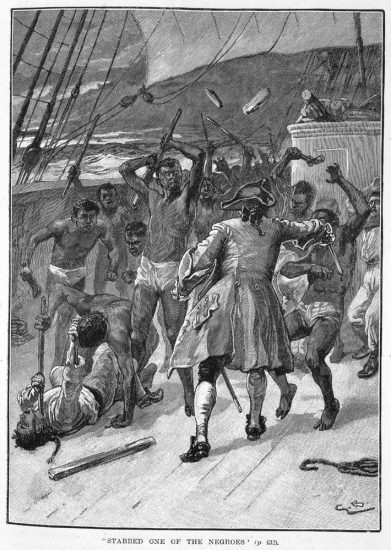
The Creole was a slave ship owned by the Johnson-Eperson Co. that set sail in November 1841 carrying 135 enslaved Afrikans & shipments of tobacco from Richmond, VA to New Orleans, LA. Among them was a brotha given the name, Madison Washington - a runaway slave from Canada who was captured in VA while searching for his wife - and his wife, given the name, Susan.
On Nov 7th, Washington along with 18 other males made their move to overthrow the ship. They overpowered the crew, killing one of the slavers in the process. The ship’s wounded captain, family, & crew survived the battle. The battle was a success though not without its cost; one of the rebels was mortally wounded and succumbed to his injury. Desperate to save his own neck, the overseer on board swore he'd navigate the ship for them.
First, the rebels demanded they set sail for Liberia, Afrika; but the long distance and low food/water supplies ixneyed that possibility. One of the rebels, a brotha given the name, Ben Blacksmen, asserted that they should aim for the British controlled islands in the West Indies; word had spread of previous rebels gaining their freedom there after overtaking American slave ships. He hoped the same fortune would befall them.

They arrived in Nassau, Bahamas 2 days later. There, they were met by the harbor pilot and his men - a crew of all local Black Bahamians. The harbor pilot declared them free once ashore. Upon discovering that the Creole's captain was also mortally wounded, the American consul was notified of the revolt and demanded the arrest of Washington & all 18 rebels implicated in his death under charges of Mutany. His wife, Susan, and the other Afrikan survivors were given leave to live freely within the British boundary of the West Indies.
Some stayed in the Bahamas to start a new life, others sailed for Jamaica to do the same. Only 5 survivors chose to remain aboard the Creole set sail for New Orleans, LA to return to American Slavery ; 3 women, 1 boy, and 1 girl. It wasn't until April 16th of the next year that Washington and the other 18 rebels were freed and joined their companions on West Indian soil as freefolk.
Moreover, for their courage, unity, & nerve, 128 enslaved Afrikan Peoples gained their freedom from this day, making the Creole Slave Revolt THE most successful revolt in U.S. history.
We pour libations of water, speak their names, & offer prayers toward their elevation - especially those lost & returned to bondage.
#hoodoo#hoodoos#the hoodoo calendar#The Creole#The Creole Slave Revolt#Slave rebellion#Slave revolt#Freedom Fighters#black history
194 notes
·
View notes
Note
Is it true that the reason Uncle Sam and several other WWII-era superheroes disappeared even before the whole McCarthy-HUAC debacle because they went to an alternate universe where the Axis won in order to continue the fight against Fascism?
The one hand, it sounds kinda crazy, even for superheroes, but in the other it sounds in-character for Uncle Sam.
Yep. I mean like you said its fucking ludicrous, even for the kind of lives that these heroes lead but its just true in this case. The Multiverse is a really hard idea to wrap your head around outside science fiction but sometimes it will come roaring in whether we like it or not.
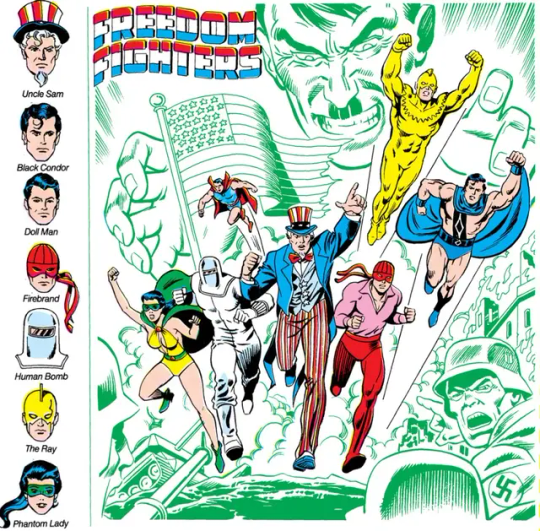
(Propaganda poster of the Freedom Fighters produced in 1946)
The Freedom Fighters were already a very insular and embattled part of the Squadron. Their specific mandate was to support resistance movements against fascism all over the world along the periphery of Axis territory where Uncle Sam's considerable influence could stave off the Spear of Destiny while they worked in secret. Their main ports of call for most of the war were in Burma, the Phillipines, China and the southern Mediterranean.
Because of the secretive and intensive nature of their work, they became a very opaque bubble within the Squadron, tightly bonded to one another with their locations and activities often unknown even to the Squadron at large for weeks or even months.
Soon after the war (as in, ON V-J Day) they became aware of the alternative universe you mentioned where the Axis managed to not only win the war but hold dominion over most, if not all, of the world.
During the entire period between the end of the war and the early days of the Justice League they were embattled as the main resistance in that universe, eventually turning the tide and overthrowing Nazi rule with the JLA's help, where they returned to our world. (Not the Firebrand on their team was the Earth X version of original Firebrand Rod Reilly, who died during the Pearl Harbor attacks on our world and did not survive the Fighters' final battle on Earth X)
I DO want to talk about Uncle Sam at some point though because as you implied he is a fascinating figure. (I've actually met him. Like, legit spoken to him, he comes into the museum like...once or twice a month. I think he knows my name)
#dc#dcu#dc comics#dc universe#superhero#comics#tw unreality#unreality#unreality blog#ask game#ask blog#asks open#please interact#freedom fighters#uncle sam#human bomb#roy lincoln#firebrand#rod reilly#phantom lady#sandra knight#black condor#richard grey jr#darrel dane#langford terrill
26 notes
·
View notes
Text
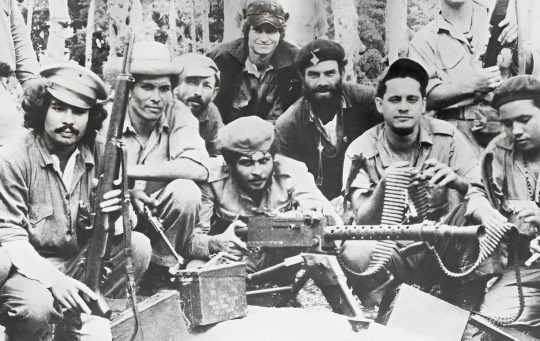
circa 1959: A group photo of Cuban citizen militia displaying weapons captured from dictator Fulgencio Batista's army in Fidel Castro's '26 of July Movement,' Cuba. The men wear army fatigues, posing around a machine gun.
#cuban revolution#1950s#cuba#cuba history#cuban#cold war#guerrillas#fidel castro#freedom fighters#che guevara#revolution#photography#tumblr#black and white#war history#resistance#dictator#batista#militar#caribbean#español#La revolución cubana#history
49 notes
·
View notes
Text

María Remedios del Valle (c. 1766–1847) was an Afro-Argentine military heroine and freedom fighter who played a crucial role in Argentina’s War of Independence (1810–1818). Known as "La Madre de la Patria" (Mother of the Nation), she fought alongside revolutionary forces against Spanish colonial rule and later endured poverty and obscurity before finally being recognized for her contributions. Her story reflects both the heroism of Black women in Latin American independence movements and the racial injustices that led to their erasure from history.
Born into slavery or servitude in Buenos Aires, María Remedios was of African descent, part of the large but often overlooked Afro-Argentine population that played a significant role in the nation’s formation. When Argentina’s fight for independence began in 1810, she joined the Army of the North, originally as a nurse caring for wounded soldiers, but soon became a combatant, engaging in battle alongside male soldiers.
She fought under General Manuel Belgrano, demonstrating exceptional bravery in battles across Argentina and present-day Bolivia and Peru. She participated in key conflicts such as the Battle of Tucumán (1812) and the Battle of Salta (1813), where she provided medical aid, carried supplies, and fought when necessary. She was captured by the Spanish, tortured, and imprisoned, yet she refused to betray the revolution. After being released, she returned to the battlefield, continuing her fight for Argentina’s independence.
Despite her immense sacrifices, María Remedios, like many Black veterans of the independence wars, was forgotten and left in poverty after the war. Argentina’s elite sought to erase the contributions of Black people to the country’s history, and she spent years living on the streets of Buenos Aires as a beggar. Eventually, she was rediscovered by political leader Juan Manuel de Rosas, who arranged for her to receive a pension in recognition of her service.
In modern Argentina, María Remedios del Valle has been reclaimed as a symbol of Afro-Argentine resistance, national identity, and the crucial role of Black people in Argentina’s independence movement. In 2013, Argentina declared November 8 as the “Day of Afro-Argentine and Afro-Culture” in her honor, ensuring that her story—and the broader contributions of Afro-Argentines—are no longer erased from history. She remains a powerful symbol of Black resilience, female heroism, and the ongoing struggle for racial recognition in Latin America.
#black history#black people#blacktumblr#black tumblr#black#pan africanism#black conscious#africa#black power#black empowering#afro argentine#María Remedios del Valle#black freedom fighters#heroine#argentina#south america
105 notes
·
View notes
Text

SMASH COMICS #14 (September, 1940). Cover by Gill Fox.
This issue presented the origin and first appearance of The Ray, one of Quality Comics' powerhouse superheroes.

The Ray first appears, albeit without pants. He would have those in the next issue, but then mysteriously be missing his distinct head fin. Art by Lou Fine, who signed his work on The Ray "E. Lectron."
The Ray would later become more well known as a member of the Freedom Fighters in Justice League of America (vol. 1) #107 (October, 1973), almost two decades after DC Comics had acquired all of Quality's characters when that company went out of business in 1956.

#Smash Comics#Bozo the Robot#Espionage#The Ray#Invisible Hood#Wings Wendall#Gill Fox#Justice League of America#Justice Society of America#Freedom Fighters#Black Canary#Green Lantern#Batman#Elongated Man#Superman#Doctor Fate#Flash#Sandman#Human Bomb#Phantom Lady#Doll Man#Uncle Sam#Black Condor#Quality Comics#Golden Age comics#Lou Fine#E. Lectron#DC Comics#Bronze Age comics#Nick Cardy
33 notes
·
View notes
Text

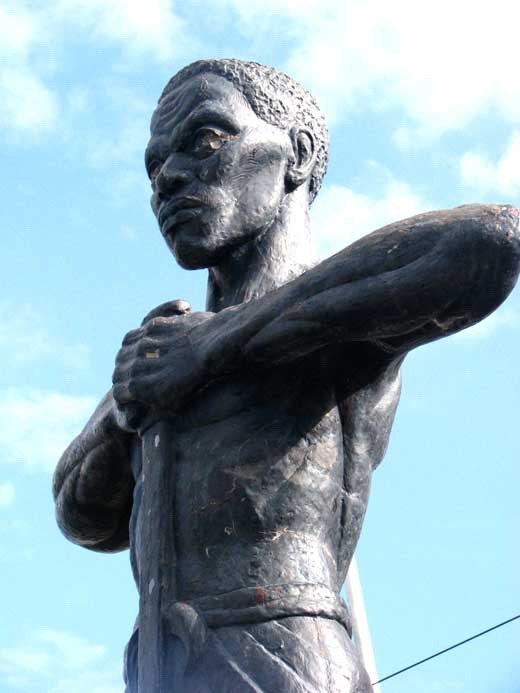
Paul Bogle led the last large scale armed Jamaican rebellion for voting rights and an end to legal discrimination and economic oppression against African Jamaicans.
Bogle owned a home in Stony Gut and had another house in Spring Garden as well as a 500 acre farm at Dunrobin making him one of the few African Jamaicans prosperous enough to pay the fee to vote.
Officially Jamaican slavery ended in 1833 after the Sam Sharpe Rebellion a year earlier. Yet from 1834 to 1838 former slaves served post-servitude “apprenticeships” to their former owners. They were also subject to a judicial system controlled by the Colonial government primarily for the benefit of the former slaveholders. They endured unemployment and taxes but low wages.
In August of 1865, Bogle led a 50 mile march of small farmers and former slaves to Spanish Town to meet with Governor Eyre to discuss their political grievances. They were denied an audience with the governor.
Two months after that attempted meeting, the Morant Bay Rebellion started, sparked by the arrest of a supporter of Bogle for protesting the conviction of another black Jamaican for trespassing on a long-abandoned plantation.
The Jamaicans, armed with sticks and stones, were protesting against injustice and widespread poverty. Most freedmen were prevented from voting by high poll taxes, and their living conditions had worsened following crop damage by floods, cholera and smallpox epidemics, and a long drought.
Bogle was captured, tried and convicted by the colonial government, and hanged on 24 October 1865 in the Morant Bay court house.
Because of his efforts Bogle was recognized as a national hero in Jamaica in 1969.
•••
Paul Bogle dirigió la última rebelión armada jamaiquina. Esta fue por el derecho al voto, el fin a la discriminación legal y la opresión económica contra los jamaiquinos africanos.
Bogle solía ser dueño de una casa en Stony Gut y tenía otra casa en Spring Garden, también una granja de quinientos acres en Dunrobin, lo que lo convertía en uno de los pocos jamaiquinos africanos lo suficientemente prósperos como para pagar la tarifa para votar.
La esclavitud en Jamaica terminó oficialmente en 1833 después de la rebelión de Sam Sharpe. Sin embargo, de 1834 a 1838, después de la servidumbre, los antiguos esclavos se convirtieron en “aprendices” de sus antiguos dueños. También estaban sujetos a un sistema judicial controlado por el gobierno colonial, el cual principalmente beneficiaba a los antiguos propietarios de esclavos. Sufrieron desempleo e impuestos.
En agosto de 1865, Bogle encabezó una marcha de cincuenta millas, tanto pequeños agricultores como ex esclavos fueron hasta Spanish Town para reunirse con el gobernador Eyre y discutir sobre las quejas políticas. Se les negó una audiencia con el gobernador.
Dos meses después de ese intento de reunión, comenzó la Rebelión de Morant Bay, provocada por el arresto de un partidario de Bogle, el cual se encontraba protestando en contra de la condena que se le había aplicado a otro jamaiquino negro por entrar ilegalmente a una plantación que había sido abandonada hace mucho tiempo.
Los jamaiquinos armados con palos y piedras, protestaron en contra de la injusticia y la pobreza generalizada. A la mayoría de las personas negras libres se les impidió votar debido a los elevados impuestos electorales, y sus condiciones de vida habían empeorado tras los daños a las cosechas causados por inundaciones, epidemias de cólera y viruela, y una larga sequía.
Bogle fue capturado, juzgado y condenado por el gobierno colonial y ahorcado el 24 de octubre de 1865 en el juzgado de Morant Bay.
Gracias a sus esfuerzos, Bogle fue reconocido como héroe nacional de Jamaica en 1969.
#jamaica#black history is everybody's history#history#freedom#freedom fighters#black history is world history#afrocentric#blackhistory#español#historyfacts#historia africana#historia#jamaican#hero#national hero#blacklivesalwaysmatter#blacklivesmatter#blackhistorymonth#blackpeoplematter#knowyourhistory#heritage#voting rights#human rights#civil rights#culture#black history month#blackhistoryyear#black history is american history#black history#black power
81 notes
·
View notes
Text

Plastic Man and the Freedom Fighters by Brian Murray
#plastic man#uncle sam#black condor#phantom lady#human bomb#midnight#manhunter#quicksilver#spider#doll man#jester#the ray#freedom fighters#fury#dyna mite#brian murray#dc comics#modern age#roy thomas#dann thomas
19 notes
·
View notes
Text
365 blk!
5 notes
·
View notes
Text

“Awesome!”
Jerry Ordway - Rick Hoberg
#all star squadron#Freedom Fighters#Uncle Sam#Phantom Lady#Doll Man#Ray#Black Condor#gunz#jerry ordway#Rick Hoberg#Earth X
54 notes
·
View notes
Text
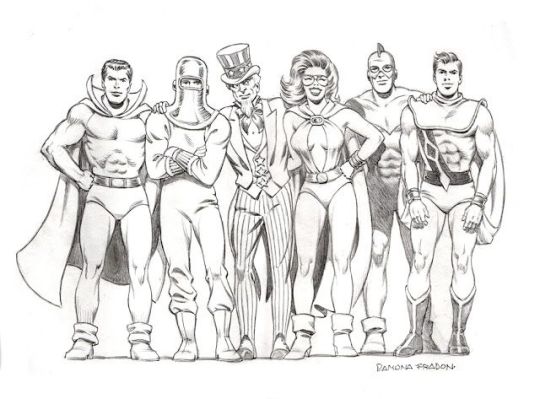
Freedom Fighters by Ramona Fradon(R.I.P.)
#ramona fradon#uncle sam dc#doll man#the human bomb#the phantom lady#the ray#black condor#freedom fighters#dc
26 notes
·
View notes